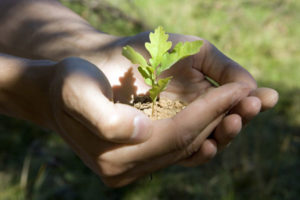
The “Love Oak” Paradox
Interest in the Oak Workshop last month in Richland Center validated a long-held belief – landowners love their oaks. And for good reason: oaks are an icon in the ecology, economy, and social fabric of life in Southern Wisconsin. Oaks sew all the land uses together, commonly found bordering farm fields, in pastures, along city boulevards, framing rural homesteads, and, of course, in woodlands. In the patchwork quilt of our landscape, oaks tie the pieces together into something whole, pleasing, and honorable.
 At the Oak Workshop, attendees wanted to understand the value of oak to songbirds, deer, and turkey, and to see their oaks as part of the larger landscape.
At the Oak Workshop, attendees wanted to understand the value of oak to songbirds, deer, and turkey, and to see their oaks as part of the larger landscape.
They learned their stately oaks have roots in a hard-scrabble upbringing – the product of disturbances to the land through fire, grazing, and blow-downs. Many were worried about the health of their trees; oak wilt disease can kill a 100-year-old, veneer-quality red oak within a year.
They were interested in timber stand improvements and invasive species control to benefit maturing oaks and woods. Even the unanswerable questions – predicting years of big acorn crops – only fueled their allure to oaks. Diversity, values, health, beauty, mystery – oaks have it all, which is why they are loved.
But this isn’t the first time love is implicated in a paradox.
Attendees learned while oak seedlings grow in partial sunlight, saplings need full sunlight. Think food consumption differences between babies and teenagers. Historically, periodic disturbances to the woods opened them up to sunlight allowing for generation after generation of oak. The following logic reveals the paradox:
Oak seedlings establish where there are acorns, but acorns don’t fall far from the parent oak tree. However, oak seedlings only become saplings in full sunlight, and therefore, mature oaks literally stand in the way of the future of our oak forests. Thus the paradox: Cutting down the tree we love will save oaks for future generations.
Cutting oak to save it
While it is true that oak is routinely harvested throughout the Driftless, scale makes all the difference for what happens next. The often repeated cycle is harvesting a few oaks and leaving mostly non-oak species standing. This can be sustainable forestry, but will never bring back oak forests. The remaining non-oak species capture the site for the foreseeable future and any oak seedlings under that canopy are certainly doomed.
An alternative that will sustain oak is to focus on the areas with sufficient oak seedlings present. During the harvest, clear all trees on 1 or 2 acres to create a patch of full sunlight. This will provide enough energy for oak seedlings to become saplings. It’s the hard-scrabble upbringing every oak needs. Working at a small scale adds flexibility, supports multiple landowner values, and focuses effort to increase success.
As we prepared for the Oak Management Workshop field trip, Mike Finlay, a forester with the Wisconsin DNR, found himself in a moment of simple clarity, “I guess what we are talking about here is we need to cut oak to save it.” Paradoxically, sometimes love asks us to do the hardest thing.
Love oak and want to learn more? Don’t miss the upcoming Oak in the Driftless Workshop in Baraboo on September 29th, 2018. Registration is open now!
